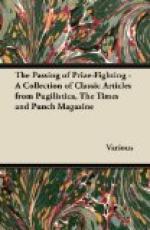* * * * *
THE SUCCULENT COMEDIANS.
Among the literary and artistic treasures of American collectors the manuscript of LAMB’S essay on Roast Pig is eminent. I have seen this rarity, which is now in the strong room where Mr. PIERPONT MORGAN keeps his autographs safe equally from fire and from theft—if not from the desire to thieve. Much did I covet in this realm of steel, and LAMB’S MS. not least. The essay occupies both sides of large sheets of foolscap, written in a minute hand, with very few corrections, both the paper and the time occupied in transcription, if not also in actual composition, being, I should guess, the East India Company’s. It is not, I imagine, the first draft, but the first fair copy after all the changes had been made and the form was fixed; and its author, if he is in any position to know what is going forward on a planet which he left some six-and-eighty years ago, must have been amused when he heard that so much money—thousands and thousands of dollars—had been given for it at auction the other day.
Reading the essay again, in the faded ink on the yellowing paper, I realised once more that everything that can be said about little pigs, dead and ripe for the eater, had been said here and said finally. But the living? That very evening I was to find little live pigs working for their maintenance under conditions of which I had never dreamed, in an environment less conducive, one would suppose, to porcine activity than any that could be selected.
It was at Coney Island, that astonishing permanent and magnified Earl’s Court Exhibition, summer Blackpool and August-Bank-Holiday-Hampstead-Heath, which New York supports for its beguilement. In this domain of switchbacks and chutes, merry-go-rounds and shooting-galleries, dancing-halls and witching waves, vociferous and crowded and lit by a million lamps, I came suddenly upon the Pig Slide and had a new conception of what quadrupeds can do for man.
The Pig Slide, which was in one of the less noisy quarters of Luna Park, consisted of an enclosure in which stood a wooden building of two storeys, some five yards wide and three high. On the upper storey was a row of six or eight cages, in each of which dwelt a little live pig, an infant of a few weeks. In the middle of the row, descending to the ground, was an inclined board, with raised edges, such as is often installed in swimming-baths to make diving automatic, and beneath each cage was a hole a foot in diameter. The spectators and participants crowded outside the enclosure, and the thing was to throw balls, which were hired for the purpose, into the holes. Nothing could exceed the alert and eager interest taken by the little pigs in the efforts of the ball-throwers. They quivered on their little legs; they pressed their little noses against the bars of the cages; their little eyes sparkled; their tails (the only corkscrews left in America) curled and uncurled and curled again: and with reason, for whereas, if you missed—as was only too easy—nothing happened, if you threw accurately the fun began, and the fun was also theirs.




